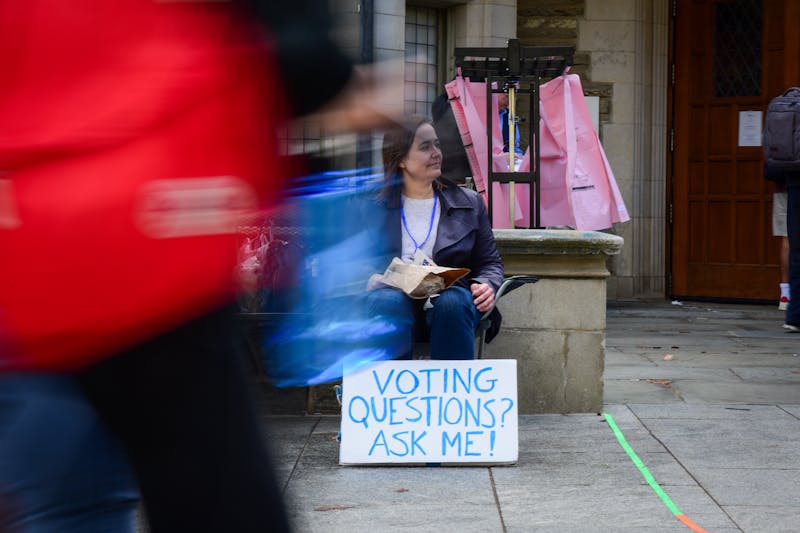
Last fall, while working on a bone marrow floor, Nursing junior Christian Perucho lost a patient half an hour into beginning his clinical. Minutes later, his student group performed postmortem procedures, caring for a body after death. It would not be the only time this happened that semester.
“I don’t know how some of the other people felt,” he said. “ I don’t know how some of my classmates might’ve taken that, if they didn’t have the mental preparation beforehand. It made me think that we never really talk about that aspect of clinical.”
Though nursing students question whether death is sufficiently addressed in the curriculum, patient loss can be a routine part of healthcare professions.
“We never really mention how to go about that as students, not just in the clinical course, but throughout the curriculum. We never really talk about what it feels like to go through the grieving process from the viewpoint of the healthcare provider,” Perucho said. He said this attitude is reflective of how people often avoid generally discussing death, despite finding his clinical faculty members supportive and understanding.
Death in the curriculum
Palliative care is currently offered as a minor in the School of Nursing, and requires two core courses and an elective. Palliative care is defined as coordinating care between families, physicians and patients with serious illnesses. This care is distinct from end-of-life and hospice care, which focus on dying or terminally ill patients.
Currently, nine students are enrolled in the Palliative care minor, and 75 have completed the program since its inception.
For students not in the minor, Penn offers a single elective case study. “Principles of Palliative care,” which Perucho has taken, “focus[es] on the care of persons with life-threatening, progressive illness,” according to the Nursing School website. He found the experience useful for approaching his clinicals and understanding how nurses experience the loss of patients.
For most students, palliative care is not a significant part of the nursing curriculum. While students understand that patient death is a possibility, Perucho said the real experience is difficult to anticipate.
“I think that’s a conversation that we haven’t really had yet. This is more a case by case basis, but we’ve never had wide or a break-out group instruction, which I would like to have in the future,” he said.
Students said that the program works hard to take care of its students, and administrators and faculty actively engage with students to ensure their wellbeing and progress toward a degree.
The Nursing School has structured its courses to help students adjust to the healthcare profession, according to Assistant Dean for Admissions and Academic Affairs Christina Costanzo Clark. Simulation labs are capped at eight students or fewer in order to cultivate strong relationships with instructors. Clark added that instructors are generally professional nurses themselves, which allows them to empathize with students.
“They do see things that they may not have seen before. Difficult things happen in healthcare.” Clark added that the school maintains a strong relationship with Counseling and Psychological Services. The school maintains two liaisons with CAPS and administrators meet regularly to discuss ways of supporting students.
“We refer students to CAPS, if something has happened in a clinical area that’s upset a student,” Clark said. “Nursing students are just like other students on campus. They get stressed during finals, but sometimes you add on the stress that they have a clinical profession.”
CAPS Director William Alexander, however, said that most of the preparation nursing students get for their clinicals comes from within the nursing school. “The students are well prepared and well trained for that, and the nursing faculty is better equipped to handle those situations ... I would guess that the faculty is really tuned in and really prepared for those situations,” he said, adding that CAPS has seen students in the past to help them deal with treating fellow Penn students.
“You know, the nursing faculty has so much experience in this area that CAPS counselors don’t have. We don’t know what it’s like to see a body on a stretcher — they do,” Alexander said.
Finding solidarity with each other
HUGS, which stands for Helping, Understanding, and Giving Support, is a growing student group that hopes to provide a space for nurses to discuss student life, mental health and professional development.
Nursing senior and HUGS President Amanda Borst said that approaching patient death is, “not a concrete part of our curriculum, but it’s something that’s very important.”
“There should be a more formal way of discussing difficult situations encountered in the healthcare professions,” she added.
She said the group members hope to discuss the Nursing School experience, and how the community and school can better support students. For some, the 2013 suicide of Nursing student Arya Singh still reverberates in conversations surrounding mental health and death.
Encountering patient loss, both in medical simulations and in hospital clinicals, has further contributed to student interest in the topic, a subject that HUGS hopes to address.
While several versions of HUGS have formed over the past few years, last semester the group gained new momentum. The organization has plans to arrange panels, and bring in a speaker to talk to student nurses about handling difficult experiences in the healthcare field.
“Since I’ve gotten here, it’s definitely gotten better,” Borst said.
'Nobody wants to talk about dying'
The American Association of Colleges of Nursing’s accreditation standards require that students be prepared to “implement patient and family care around resolution of end-of-life and palliative care issues, such as symptom management, support of rituals, and respect for patient and family preferences.”
However, a National Institute of Medicine brief published in 2014 reported that few health-care professionals, including nurses, are trained in palliative and hospice care. Penn Nursing professor Salimah Meghani, who contributed to the report, said that beyond the palliative care minor, Penn, like many schools, does “not offer a lot of training.”
Meghani said that the current state of care reflects the United States’ fragmented approach to healthcare. She pointed to a Dartmouth College report on the treatment of late-stage cancer, which concluded that dying patients can see more than ten or more physicians in the last six months of their lives.
With such a complicated approach to care, it is difficult to coordinate an emotionally and physically supportive relationship between a patient, family and physicians.
“Nobody wants to talk about dying,” she said.
'Nursing School becomes a completely different game'
Perucho said that it is difficult to discuss the intense experience of clinicals with those outside the program — what he calls a “hidden stressor.” Demanding schedules that can stretch from 5 a.m. to 9 p.m. widen the separation felt between Nursing students and those enrolled in the other undergraduate schools.
Students are assigned their first patients during their sophomore year, and by the fall of their junior year can spend almost three-quarters of their time in hospital settings. The third year Nursing program includes a separate course that focuses on treating older patients, where students are more likely to see and talk about patients passing away, according to Clark.
Beyond clinicals, the nursing curriculum is demanding. Exams in the Nursing School are two-fold; for many classes, students must pass a traditional test, while also perform the tasks that they have learned in the semester. “In every health discipline school across the country, because it’s a very practically based profession, you have a lot of simulation test-outs,” said Christian, can be the most stressful part of the Nursing curriculum.
Christian says the mental health needs of students shift as training transitions from the classroom to a clinical environment, when faculty emphasis on mental health increases. “Nursing School becomes a completely different game,” he said.
And while younger students may have to confront a stressful workload and difficult tests, Perucho said “that conversation is completely different from being in a clinical setting and talking about ‘my patient just died in front of me’ or ‘I watched a patient code.’”
The Daily Pennsylvanian is an independent, student-run newspaper. Please consider making a donation to support the coverage that shapes the University. Your generosity ensures a future of strong journalism at Penn.
DonatePlease note All comments are eligible for publication in The Daily Pennsylvanian.







